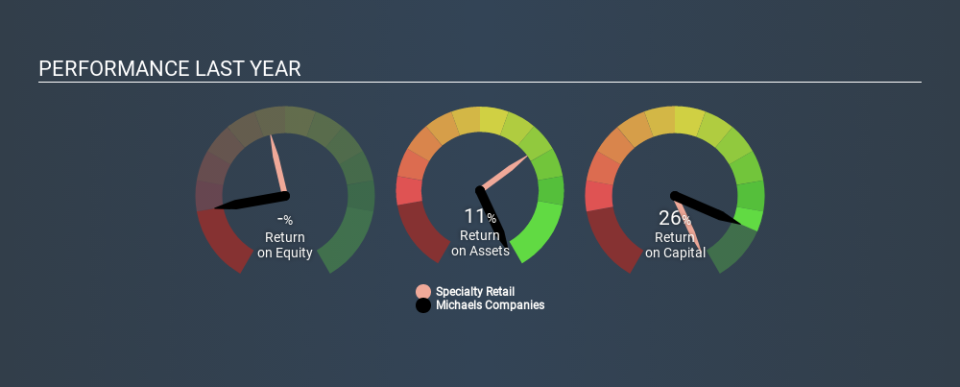Should You Like The Michaels Companies, Inc.’s (NASDAQ:MIK) High Return On Capital Employed?

Today we'll evaluate The Michaels Companies, Inc. (NASDAQ:MIK) to determine whether it could have potential as an investment idea. In particular, we'll consider its Return On Capital Employed (ROCE), as that can give us insight into how profitably the company is able to employ capital in its business.
First, we'll go over how we calculate ROCE. Next, we'll compare it to others in its industry. Finally, we'll look at how its current liabilities affect its ROCE.
Return On Capital Employed (ROCE): What is it?
ROCE measures the 'return' (pre-tax profit) a company generates from capital employed in its business. All else being equal, a better business will have a higher ROCE. Ultimately, it is a useful but imperfect metric. Renowned investment researcher Michael Mauboussin has suggested that a high ROCE can indicate that 'one dollar invested in the company generates value of more than one dollar'.
So, How Do We Calculate ROCE?
The formula for calculating the return on capital employed is:
Return on Capital Employed = Earnings Before Interest and Tax (EBIT) ÷ (Total Assets - Current Liabilities)
Or for Michaels Companies:
0.26 = US$630m ÷ (US$3.8b - US$1.4b) (Based on the trailing twelve months to November 2019.)
So, Michaels Companies has an ROCE of 26%.
See our latest analysis for Michaels Companies
Is Michaels Companies's ROCE Good?
ROCE can be useful when making comparisons, such as between similar companies. Using our data, we find that Michaels Companies's ROCE is meaningfully better than the 11% average in the Specialty Retail industry. I think that's good to see, since it implies the company is better than other companies at making the most of its capital. Putting aside its position relative to its industry for now, in absolute terms, Michaels Companies's ROCE is currently very good.
We can see that, Michaels Companies currently has an ROCE of 26%, less than the 61% it reported 3 years ago. So investors might consider if it has had issues recently. The image below shows how Michaels Companies's ROCE compares to its industry, and you can click it to see more detail on its past growth.
It is important to remember that ROCE shows past performance, and is not necessarily predictive. ROCE can be deceptive for cyclical businesses, as returns can look incredible in boom times, and terribly low in downturns. ROCE is only a point-in-time measure. Future performance is what matters, and you can see analyst predictions in our free report on analyst forecasts for the company.
What Are Current Liabilities, And How Do They Affect Michaels Companies's ROCE?
Current liabilities are short term bills and invoices that need to be paid in 12 months or less. The ROCE equation subtracts current liabilities from capital employed, so a company with a lot of current liabilities appears to have less capital employed, and a higher ROCE than otherwise. To counteract this, we check if a company has high current liabilities, relative to its total assets.
Michaels Companies has total assets of US$3.8b and current liabilities of US$1.4b. As a result, its current liabilities are equal to approximately 36% of its total assets. A medium level of current liabilities boosts Michaels Companies's ROCE somewhat.
What We Can Learn From Michaels Companies's ROCE
Despite this, it reports a high ROCE, and may be worth investigating further. There might be better investments than Michaels Companies out there, but you will have to work hard to find them . These promising businesses with rapidly growing earnings might be right up your alley.
For those who like to find winning investments this free list of growing companies with recent insider purchasing, could be just the ticket.
If you spot an error that warrants correction, please contact the editor at editorial-team@simplywallst.com. This article by Simply Wall St is general in nature. It does not constitute a recommendation to buy or sell any stock, and does not take account of your objectives, or your financial situation. Simply Wall St has no position in the stocks mentioned.
We aim to bring you long-term focused research analysis driven by fundamental data. Note that our analysis may not factor in the latest price-sensitive company announcements or qualitative material. Thank you for reading.


